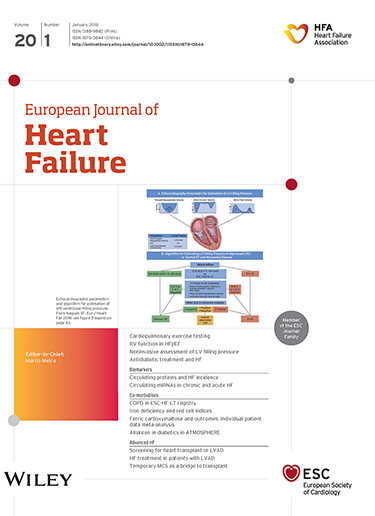Clinical and echocardiographic phenotype of cardiac wasting in patients with advanced cancer.
IF 10.8
1区 医学
Q1 CARDIAC & CARDIOVASCULAR SYSTEMS
引用次数: 0
Abstract
AIMS Cardiac wasting-associated cardiomyopathy in patients with advanced cancer is characterized by loss of left ventricular (LV) mass and independently associated with poor prognosis. Better understanding of this very prevalent cardiomyopathy is urgently needed. METHODS AND RESULTS Overall, 398 patients with active, mostly advanced cancer without significant cardiovascular disease (mean LV ejection fraction [LVEF] 64.3 ± 0.2%) or active infection were prospectively examined (mean age 60 ± 1 years, 50% women, body mass index 25.0 ± 0.2 kg/m2, 26% cachectic). Patients were categorized and compared by quartiles of LV mass/height2. LVEF, global longitudinal strain (GLS), and anticancer therapy naive status were similar across quartiles. Patients in Q1 (lowest LV mass quartile) were younger, more likely cachectic, had lower: BMI, 10-step stair-climbing power, tricuspid annular plane systolic excursion (TAPSE), stroke volume, cardiac output, and higher heart rate. In repeat follow-up assessments after 140 ± 8 days (n = 143), LVEF, TAPSE, LV mass, left atrial volume, and GLS were found reduced (all p ≤ 0.002). Only in those with above-median LV mass at baseline, cardiac output and heart rate increased during follow-up - in those with below-median LV mass, mitral E/A decreased. CONCLUSIONS Patients with advanced cancer with low LV mass have a distinct phenotype characterized by lower cardiac chamber volumes, stroke volume, and cardiac output, but normal LVEF and GLS that may be the distinct feature of cardiac wasting-associated cardiomyopathy.晚期癌症患者心脏消耗的临床和超声心动图表型。
晚期癌症患者心肌萎缩相关心肌病的特征是左心室(LV)肿块减少,且独立与预后不良相关。迫切需要更好地了解这种非常普遍的心肌病。方法和结果对398例无明显心血管疾病(平均左室射血分数[LVEF] 64.3±0.2%)或活动性感染(平均年龄60±1岁,50%为女性,体重指数25.0±0.2 kg/m2, 26%为病毒质)的活动性晚期癌症患者进行前瞻性检查。患者按左室质量/高度四分位数进行分类和比较2。LVEF、全局纵向应变(GLS)和抗癌治疗初始状态在四分位数之间相似。Q1(最低左室质量四分位数)的患者更年轻,更有可能是病质,BMI较低,10步爬楼梯能力,三尖瓣环平面收缩位移(TAPSE),每搏量,心输出量,心率较高。在140±8天(n = 143)后的重复随访评估中,LVEF、TAPSE、左房质量、左房容积和GLS均降低(p≤0.002)。只有基线时左室质量高于中位数的患者,随访期间心输出量和心率增加,而左室质量低于中位数的患者,二尖瓣E/A下降。结论低左室质量的晚期癌症患者具有明显的表型,其特征是心室容量、卒中容量和心输出量较低,但LVEF和GLS正常可能是心消耗相关性心肌病的明显特征。
本文章由计算机程序翻译,如有差异,请以英文原文为准。
求助全文
约1分钟内获得全文
求助全文
来源期刊

European Journal of Heart Failure
医学-心血管系统
CiteScore
27.30
自引率
11.50%
发文量
365
审稿时长
1 months
期刊介绍:
European Journal of Heart Failure is an international journal dedicated to advancing knowledge in the field of heart failure management. The journal publishes reviews and editorials aimed at improving understanding, prevention, investigation, and treatment of heart failure. It covers various disciplines such as molecular and cellular biology, pathology, physiology, electrophysiology, pharmacology, clinical sciences, social sciences, and population sciences. The journal welcomes submissions of manuscripts on basic, clinical, and population sciences, as well as original contributions on nursing, care of the elderly, primary care, health economics, and other related specialist fields. It is published monthly and has a readership that includes cardiologists, emergency room physicians, intensivists, internists, general physicians, cardiac nurses, diabetologists, epidemiologists, basic scientists focusing on cardiovascular research, and those working in rehabilitation. The journal is abstracted and indexed in various databases such as Academic Search, Embase, MEDLINE/PubMed, and Science Citation Index.
 求助内容:
求助内容: 应助结果提醒方式:
应助结果提醒方式:


